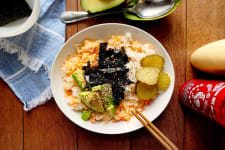
Kickstart Your Baby’s Brain Health with the Superfood of the Sea
June 16th, 2020Introducing Wild-Caught Seafood to Your Kids
Before you read further, an important reminder: The World Health Organization does not recommend feeding complementary foods to your infant until at least six months of age.
When you have a versatile rotation of wild Alaskan seafood recipes on hand, your growing infant can enjoy some of the same wild-caught flavors as the older folks at the kitchen table (barring any allergies or food restrictions, of course).
All you need is a little culinary vision and some basic kitchenware to give some of your favorite “grown-up” recipes a Benjamin Button-style treatment, turning them into baby-friendly purées — delicious enough that you won’t mind eating whatever they leave unfinished on their little plates.
Why Wild-Caught Seafood for Babies?
We’d be remiss to mention what makes wild-caught seafood an optimal protein choice for infants who are old enough to enjoy multi-ingredient baby purées.
Consuming omega-3s like EPA and DHA from a young age — in fact, even in utero — presents significant developmental benefits that last through early childhood and beyond. You can read more about this in our blog post about why wild-caught, omega-3-rich seafood is the ultimate brain food for your kid.
While EPA and DHA are found in a variety of seafoods, wild-caught Alaskan species consistently rank high on a list of “best choices” from experts due to what they do and don’t contain. Particular omega-3-rich fish like wild-caught salmon, cod, halibut, pollock, and rockfish are all low in contaminants, as are scallops and spot prawns, making them an excellent source of these essential nutrients without any of potentially detrimental chemicals like mercury in seafood higher up the food chain; or PCBs, which originate in hazardous waste runoff that often contaminates farmed seafood.
Making a baby purée with wild-caught seafood ensures that you’re feeding your infant the purest catch available.
Special Precautions When Feeding Fish to Infants
Please consult your pediatrician to go over any food restrictions or additions that your baby might require at different stages in their development. You don’t want to get creative with the ingredients you’re putting into your baby purées without guidance from an expert first on when your infant’s digestive system is ready for certain foods.
Once you get the go ahead from the doctor, there are a few other precautions you’ll want to take in the kitchen.
When preparing meals for infants and young children, you absolutely must check for pin bones that may be left in the fillets. We remove the pin bones from our fish by hand to preserve the integrity of the fillets, but sometimes human error occurs, so we recommend feeling for them just in case.
You will have to remove any remaining pin bones at home, but don’t worry: It’s very easy to do. Please consult our blog post that tells you how to remove pin bones properly, which is an essential kitchen skill whether you have a baby or not. As an extra measure of precaution, you may decide to pass your purée through a mesh sieve before serving or storing to catch any pin bones that may have been missed.
Another important precaution you will want to take when cooking wild-caught seafood for your baby: Cook your seafood through. This is the same recommendation for any meat source, as babies’ gastrointestinal symptoms are still developing; feeding undercooked or raw seafood and meats to infants can lead to serious health risks.
What to Look for When You’re Adapting Your Favorite Recipes for Baby
With a standing or immersion blender on hand, you have the means to adapt proper grown-up recipes into a baby purée that incorporates wild-caught seafood. The following recipes are examples that can feed everyone at the table, including your youngest, as they are easily blended into a smooth purée, or a chunkier mash as your child begins to crave and handle more texture.
Casseroles are a good option when you’re looking for a recipe with purée potential, as many of them already contain elements that will come together readily in a blender. This fish pie from Mary-Francis Heck is a modern take on Irish Fish Pie, with a mix of seafood and topped with sweet potatoes rather than white potatoes. To make it baby-friendly, you’ll simply be taking a break at Step 5 to reserve a small portion of milk-poached seafood to blend with the sweet potato purée, adding in a little poaching liquid or sweet potato cooking liquid if you think it needs to be thinned out a bit. Save the bechamel sauce and other buttery additions for the adults at the table.
Chowders, too, are easily adaptable. Maria Ushakova’s coconut milk-based salmon and corn chowder, with a colorful mix of vegetables, is healthy and full of flavor. While the recipe calls for salmon steaks, simply use sockeye or coho fillets. To make this into a purée, grab a slotted spoon to transfer a portion of the chowder to a standing blender or a small bowl in which to use a hand blender; you may not need any of the broth to form a good consistency in the purée. Blend until smooth, adding in broth if needed.
Steamed fish and veggies are a cinch to blend up into a purée, as this cooking method helps foods retain much of their moisture; you may not need to add any additional liquid for a thinner consistency. Real Simple’s steamed halibut and veggies recipe is ridiculously easy to make. When adapting it for your infant, just make sure to save the lemon garnish for the adults at the table.
Again, as long as your pediatrician gives you the green light to introduce specific ingredients to your infant, you can adapt many of your favorite recipes so that your growing little one can grow to enjoy wild-caught seafood as much as you do.




